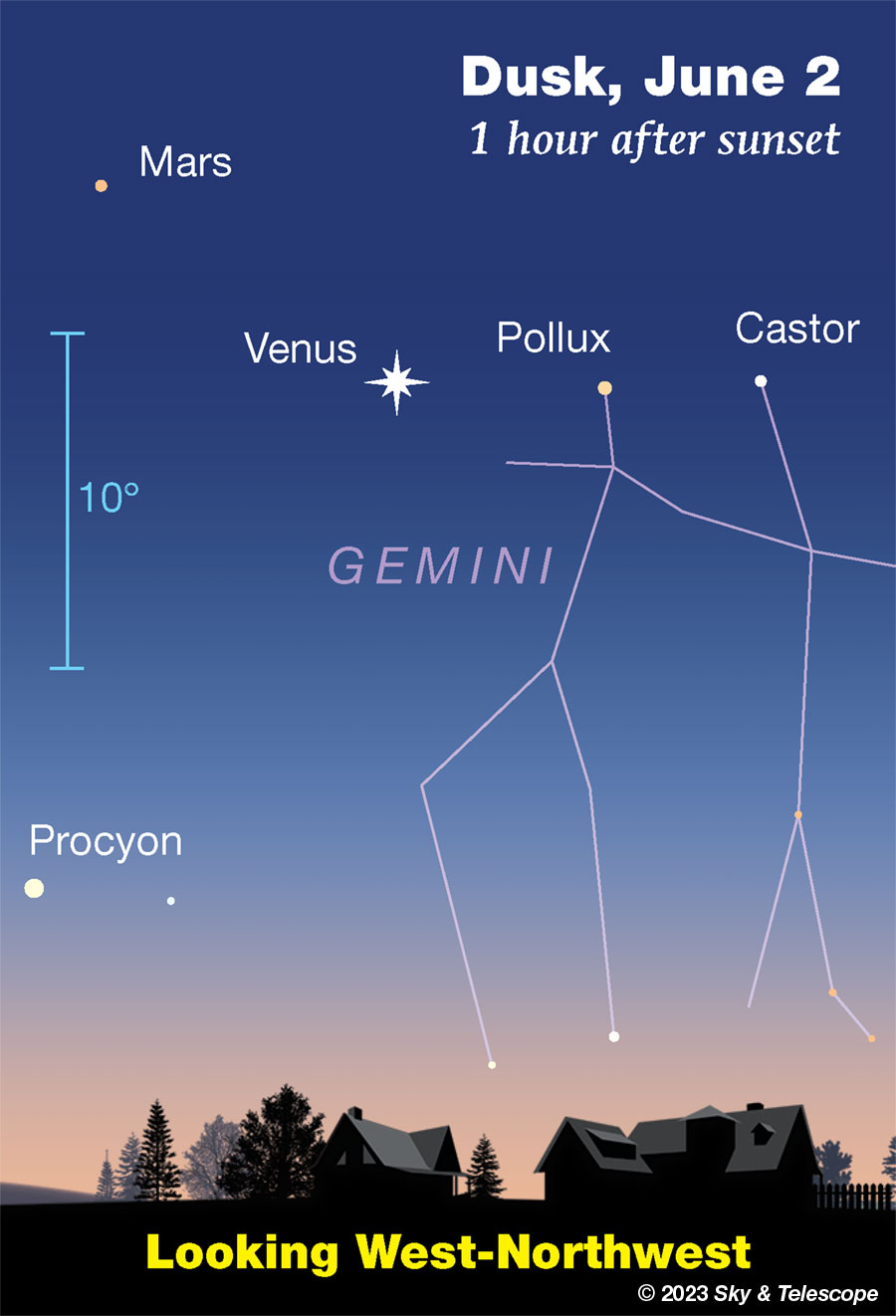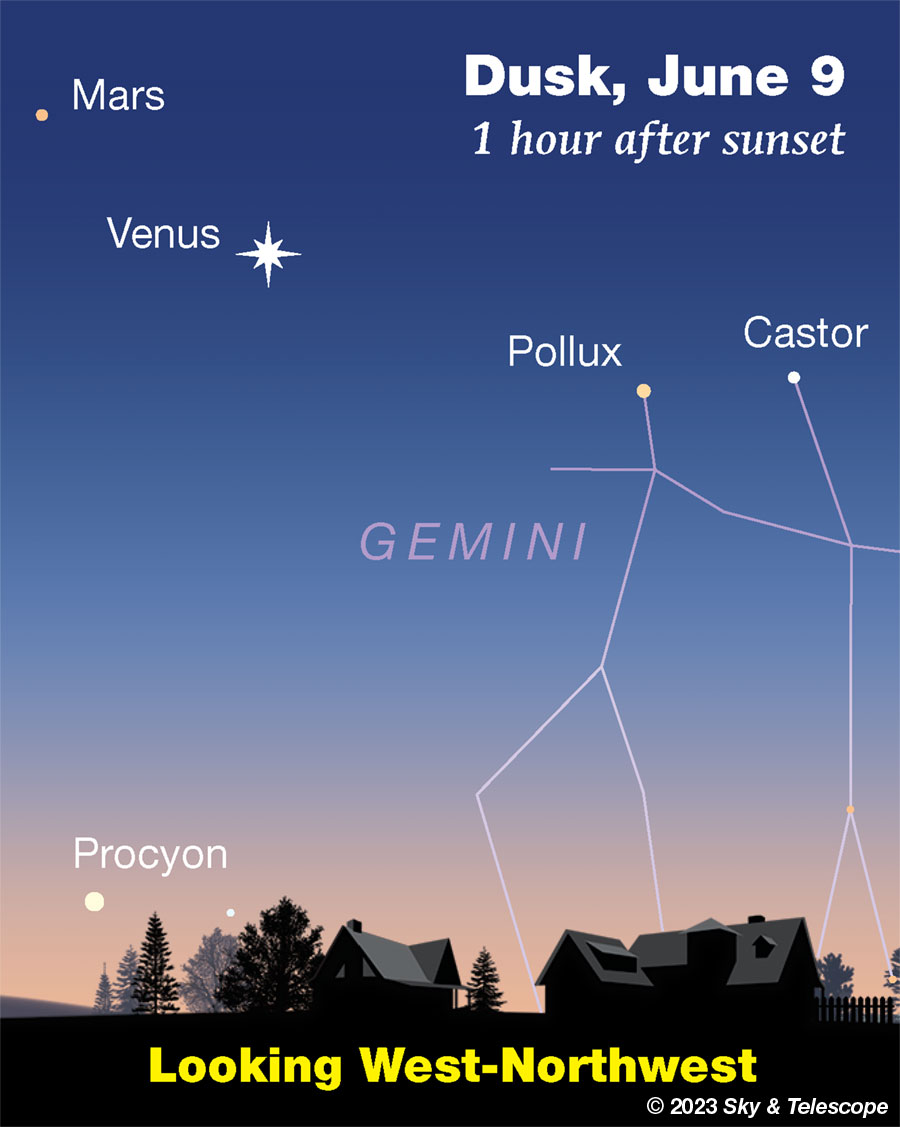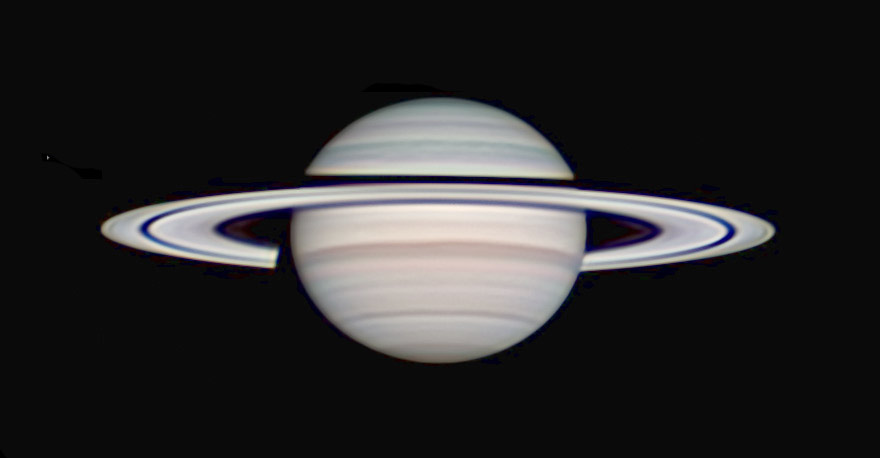Supernova in the Pinwheel Galaxy, update May 28th: SN 2023ixf continues to hold at about magnitude 11.0, where it has been since May 23rd following its discovery at mag 14.9 on May 19th.
But unfortunately the Moon is getting bright. This evening, using my 12.5-inch reflector at 75×, I identified the supernova itself at precisely the right spot using the good charts in the article linked below. But the moonlight and the slight haze of the humid night made the huge, low-surface-brightness glow of M101 almost undetectable. I doubt that a smaller scope would have worked for M101 at all in these conditions. Still, it was amazing to see an individual star, looking like any other faint white star in the eyepiece, at a distance of 21 million light-years.
The moonlight will get worse for about the next week. Then on June 5th or 6th a window of moonless darkness starts opening between the end of twilight and moonrise.
Supernovae usually stay bright for weeks, and there's no telling what this one might do next. See our article Bright Supernova Blazes in M101, the Pinwheel Galaxy (with those charts).
FRIDAY, JUNE 2
¦ Venus remains in line with Castor and Pollux this evening, as shown below, though not as precisely as it was yesterday evening. During the course of this week, watch the two stars move farther to Venus's lower right, while Mars approaches Venus more slowly from the upper left.
 Catch the Venus-Pollux-Castor lineup at dusk. Meanwhile Mars over there looks forlorn, but it's putting on a performance of its own . . . .¦ Mars shines inside the Beehive cluster, M44, near the central beehive-shaped asterism itself (which is currently tilted right). Use binoculars after twilight ends or, better, a telescope. Catch the Venus-Pollux-Castor lineup at dusk. Meanwhile Mars over there looks forlorn, but it's putting on a performance of its own . . . .¦ Mars shines inside the Beehive cluster, M44, near the central beehive-shaped asterism itself (which is currently tilted right). Use binoculars after twilight ends or, better, a telescope.
Mars is moving east across the cluster at about 90 arcseconds per hour. Can you see its position change with respect to the stars in as little as a half hour? Note the shape it makes with the closest faint stars to it that you can see, as noted in the June Sky & Telescope, page 49.
Venus will follow in Mars's footsteps past the Beehive on June 12th and 13th.
SATURDAY, JUNE 3
¦ Full Moon (exact at 11:43 p.m. EDT). Look for orange Antares just 3° or 4° to the Moon's upper right this evening. Binoculars will help pull Antares out of the bright moonglare.
And upper right of Antares by 7½° is Delta Scorpii, about half as bright but less blasted by moonlight. Delta Sco is the middle, and brightest, of the three stars forming the head of Scorpius. Use those binocs.
SUNDAY, JUNE 4
¦ Vega is the brightest star in the east-northeast after dark. Look 14° (about a fist and a half at arm's length) to Vega's upper left for Eltanin, the 2nd-magnitude nose of Draco the Dragon. Closer above and upper left of Eltanin are the three fainter stars forming the rest of Draco's stick-figure head, also called the Lozenge; the faintest of them is 4th magnitude. Draco always points his nose to Vega.
MONDAY, JUNE 5
¦ Bright Arcturus shines pale yellow-orange high overhead toward the south these evenings. The kite shape of Boötes, its constellation, extends up from Arcturus as you face south. The kite is narrow, slightly bent to the right, and 23° long: about two fists at arm's length.
TUESDAY, JUNE 6
¦ As we count down the last two weeks to official summer (the solstice is on June 21st this year), the Summer Triangle stands high and proud in the east after dark. Its top star is bright Vega. Deneb is the brightest star to Vega's lower left, by 2 or 3 fists at arm's length. Look for Altair a greater distance to Vega's lower right. Altair is midway in brightness between Vega and Deneb.
If you have a dark enough sky, the Milky Way runs across the lower part of the Summer Triangle from side to side.
WEDNESDAY JUNE 7
¦ Leo's tail star, 2nd-magnitude Denebola high in the south-southwest after dark, forms an almost perfectly equilateral triangle with brighter Spica off to its left and Arcturus, brighter still, above them. All three sides of the triangle are close to 35° long (35.3°, 35.1°, and 32.8°). S&Tcolumnist George Lovi named this the Spring Triangle nearly a half century ago, but the name never really caught on. For such a near-perfect equilateral, I think its special name ought to be revived.
THURSDAY, JUNE 8
¦ Vega is the brightest star high in the east after dark. Barely lower left of it is 4th-magnitude Epsilon Lyrae, the Double-Double. Epsilon forms one corner of a roughly equilateral triangle with Vega and Zeta Lyrae. The triangle is less than 2° on a side, hardly the width of your thumb at arm's length.
Binoculars easily resolve Epsilon. And a 4-inch telescope at 100× or more should resolve each of Epsilon's wide components into a tight pair.
Zeta Lyrae is also a double star for binoculars; much tougher, but plainly resolved in any telescope.
Delta Lyrae, below Zeta, is a much wider and easier pair, orange and blue.
FRIDAY, JUNE 9
¦ The Big Dipper hangs high in the northwest as the stars come out. The Dipper's Pointers, currently its bottom two stars, point lower right toward Polaris. Above Polaris, and looking very similar to it, is Kochab, the lip of the Little Dipper's bowl. (The rest of the Little Dipper is mostly dim.)
Kochab stands precisely above Polaris around the end of twilight or a little after. How accurately can you time this event for your location, perhaps using the vertical edge of a building?
 Venus says goodbye Pollux, hello Mars.¦ Saturn rises around 1 a.m. Saturday morning (daylight-saving time), followed less than a half hour later by the Moon, nearly last quarter and 6° or 7° to Saturn's lower left. By early dawn the two of them are well up in the southeast. Venus says goodbye Pollux, hello Mars.¦ Saturn rises around 1 a.m. Saturday morning (daylight-saving time), followed less than a half hour later by the Moon, nearly last quarter and 6° or 7° to Saturn's lower left. By early dawn the two of them are well up in the southeast.
SATURDAY, JUNE 10
¦ Spica is straight below Arcturus not long after dark. Half as far to Spica's lower right is the four-star pattern of Corvus, the springtime Crow, rather compact. Spring will soon be over; catch Corvus before it sinks too low and departs from the evening sky until next year.
¦ Last-quarter Moon (exact at 3:31 p.m. EDT). The Moon rises tonight around 2 a.m. daylight-saving time, lower right of the Great Square of Pegasus and lower left of Saturn.
SUNDAY, JUNE 11
¦ Here it is almost summer. But as twilight fades, look very low in the north-northwest for wintry Capella very out of season. The farther north you are, the less low it will appear. You may need binoculars. If you're as far north as Montreal or either of the Portlands (Oregon and Maine), Capella is actually circumpolar.
ADVERTISEMENT
THIS WEEK'S PLANET ROUNDUPMercury is deep in the glow of sunrise, brightening from magnitude +0.2 to –0.3 this week. Use binoculars to try for it well to the lower left of brighter Jupiter. They're moving apart, from 15° separation on the morning of June 3rd to 22° on the 10th.
Venus (magnitude –4.4, in Cancer) is the brilliant "Evening Star" in the west from twilight into late evening. It's not quite as high in the dusk as it was a couple weeks ago, but it doesn't set until about 1½ hours after full dark.
Venus starts the week still nearly in line with Castor and Pollux, then moves farther out of line every day.
In a telescope Venus is a dazzling little half-Moon shape, just starting to show signs of turning into a fat crescent. It enlarges a little every day while waning in phase. Venus will become a bigger, thinning crescent dropping lower until it's lost from sight in mid- to late July.
Mars (magnitude 1.6, in Cancer) glows weakly to the upper left of Venus, by a slowly shrinking distance: 10° on the evening of June 2nd, 8° by June 9th. That's not quite a fist at arm's length.
But no conjunction is in store. Mars and Venus will reach a minimum separation of 3.6° on June 30th, then they'll start to draw apart again as Venus plunges down toward the sunset. This is called a quasi-conjunction, because they don't pass each other although they do get within 5° of each other.
In a telescope Mars is just a tiny little blob 4½ arcseconds in diameter, since it's on the far side of its orbit from us.
Jupiter (magnitude –2.1, in Aries) is low in the east as dawn brightens. It might be easiest to see about 60 to 45 minutes before sunrise.
Saturn (magnitude +1.0, in dim Aquarius) is well up in the southeast by the beginning of dawn.
 Saturn on April 29th, imaged by Christopher Go from latitude 10° north in the Philippines. South here is up. Contrast has been enhanced. Notice how much the rings have closed toward edge-on since last year. Saturn on April 29th, imaged by Christopher Go from latitude 10° north in the Philippines. South here is up. Contrast has been enhanced. Notice how much the rings have closed toward edge-on since last year.
Also notice the black on each side of the rings where they cross the planet's disk. The dark black south of (above) the rings is their shadow on the globe. The thinner, slightly grayer black to their north is the dim, sparse inner C ring, seen in front of the planet's bright face.Uranus, magnitude 5.9, is hidden low in the sunrise.
Neptune, magnitude 7.9 at the Aquarius-Pisces border, is low in the east-southeast before dawn begins. |





 Catch the Venus-Pollux-Castor lineup at dusk. Meanwhile Mars over there looks forlorn, but it's putting on a performance of its own . . . .¦ Mars shines inside the Beehive cluster, M44, near the central beehive-shaped asterism itself (which is currently tilted right). Use binoculars after twilight ends or, better, a telescope.
Catch the Venus-Pollux-Castor lineup at dusk. Meanwhile Mars over there looks forlorn, but it's putting on a performance of its own . . . .¦ Mars shines inside the Beehive cluster, M44, near the central beehive-shaped asterism itself (which is currently tilted right). Use binoculars after twilight ends or, better, a telescope. Venus says goodbye Pollux, hello Mars.¦ Saturn rises around 1 a.m. Saturday morning (daylight-saving time), followed less than a half hour later by the Moon, nearly last quarter and 6° or 7° to Saturn's lower left. By early dawn the two of them are well up in the southeast.
Venus says goodbye Pollux, hello Mars.¦ Saturn rises around 1 a.m. Saturday morning (daylight-saving time), followed less than a half hour later by the Moon, nearly last quarter and 6° or 7° to Saturn's lower left. By early dawn the two of them are well up in the southeast. Saturn on April 29th, imaged by
Saturn on April 29th, imaged by